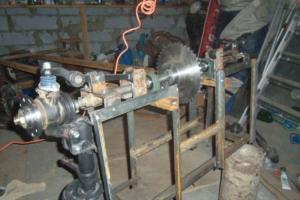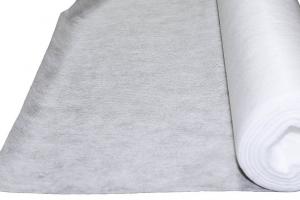As a result of long-term or intensive use, high-quality sneakers can wear out in the sole area much faster than their upper part fails. For those who have such a problem, this master class will help. The rubber sole for the sneakers will be made from an old tire.
Materials
For this shoe update you will need:
- old tire or new (if there is only one and no one needs it);
- good glue for rubber (ideally professional glue for repairing tires);
- sharp knife;
- acetone;
- cotton wool or rag;
- the sneakers themselves.

Step 1. Use a knife to cut off a piece of the tire. Cut off the central part. The length of the piece should be equal to the length of a pair of sneakers, the width should be the width of the widest part of the sole. Cut so that you are left with the top of the tire.



Step 2. Degrease the sole of the sneakers and a piece of cut rubber by wiping it with a rag soaked in acetone. Don't forget to thoroughly wash your sneakers first.
Step 3. Place a sneaker on the wrong side of a piece of tire and trace its outline with chalk. Do the same with the second copy.

Step 4. Cut the tire into two parts. Lubricate each of them with glue.

Step 5. Put on your sneakers and stand on the tire, trying to get into the previously marked contour. Stand for fifteen minutes without moving for better adhesion of materials. Afterwards, carefully remove your foot, press the sneakers down with a press and leave for the time specified in the instructions for the glue. Most often, the gluing time is 24 hours.

Step 6. After the glue has dried, use a knife to cut off any excess.
When it comes to DIY fashion pieces, shoes can't be ignored. Handmade shoes are a fun and unique way to personalize your wardrobe, as well as give some items a second life that can serve as a great example for others. And this time we'll show you a pair of retro sneakers made from old tires and denim scraps.
The idea to create these homemade sneakers came from watching the Tarahumara races. The Tarahumara are an indigenous people who live in an area with massive canyons. Residents walk incredible distances wearing homemade sandals made from old tires, called hauraches. For ordinary people, such sandals are not particularly comfortable, so below we describe how to make more comfortable shoes using the same tires.
Necessary materials for making homemade sneakers:
Aluminium foil;
Old sneakers;
Boot glue;
Old tires or a flat piece of rubber, about 6-8 millimeters;
Old jeans or other durable fabric;
Fabric waste;
20 krengels (iron spacers);
Hammer;
Sewing machine;
Sewing pins;
Rubber bands (rubber bands);
Clothespins;
A good pair of large scissors;

Making sneakers from tires
1) Get a pair of old sneakers that fit you well. Cut a sheet of aluminum foil long enough and wide enough to wrap around the entire length of one shoe. Wrap the aluminum foil around the shoe so that the 2 ends meet at the heel and the sole is completely wrapped.

2) Take a marker and use it to trace the outline of the top of the shoe sole onto the aluminum foil. Then turn the shoe over and continue drawing a line on the foil until it closes. Also outline the upper part of the sneakers, not forgetting about the recess for the tongue.
3) Cut the foil along the lines you drew. Attach the trace cut out of foil and trace a “template” around it with a fabric marker. Do the same to create a second trace. Don’t forget to also draw another outline next to each of the footprints, one centimeter from the previous outline. Only then cut out both traces.
4) Now take the top part of the foil, cut it along the contour and unfold it so that it does not tear. Place it on the fabric and carefully trace the outline with a marker. Here, too, adhere to the tactic that you will need to draw another circuit for the firmware. Cut out fabric blanks.
5) You will also need to cut out the tongue for the shoe from the fabric. It should be about 10 centimeters wide and 18 centimeters long. As a last resort, you can then shorten it later when you need to sew it to the shoe. Sew along the edges of the fabric that will be visible when the shoes are completely finished. To do this, wrap about 5 centimeters of fabric and sew it using a machine. This doesn't just apply to reeds.
6) Take the krengels (iron spacers) and secure them in the upper fabric part of the sneakers, 10 pieces for each (5 on each side), after making small holes. Use a hammer. These will be the holes for our laces. Attach the tongue with sewing pins to the inside of the shoe and adjust it the way you want it to look.
Using different colored fabrics to cut out shapes to decorate your shoes. Then sew them all the way around the edges of the top of the sneakers. You should get it as shown in the photo.

7) Now the blanks can be wrapped around the legs and secured with sewing pins so that nothing stings anywhere. But remember that at the moment the outer part of them should be inside. Take the laces and thread them through the holes, tying them off. This way you can see how the sneakers will fit on your feet.

8) Remove the workpiece and lace it again. Turn the pieces inside out (that is, leave them the way you put them on). Now carefully secure the part that is responsible for the sole, and carefully sew everything together. Do the same for the second sneaker, sewing the blanks together.

9) Remember that you need to stitch along the black marker line that you applied to the fabric. Be sure to leave a little extra space around the toe of the shoe. It will probably tighten up as you glue the sole. Turn the shoes inside out so that the right side remains on top.

10) Put your shoes on your feet to make sure they fit well. Turn it inside out again, and go over the second seam again to strengthen the stitching. You can also make some adjustments at any point and trim excess fabric to ensure the shoe fits comfortably.
11) Now take a knife and carefully cut the sides of the tires so that only the flat part remains. Now attach a trace of foil and with a marker, outline it on the tire twice so that there are two traces. Cut them out.
There may be many reasons why you might be left without shoes in field or hiking conditions far from populated areas. Here’s an option: the shoes were left to dry by the fire, but you weren’t careful and they were partially burned. Another option: Your dog, playing with a shoe on the bank of a mountain stream, accidentally dropped it, and the shoe quickly floated downstream. The dog liked this dynamic scene and repeated the procedure with the second shoe.
How to make your own shoes from nothing
But now we won’t talk about the reasons why you lost your shoes. In the off-season or winter, you need to find an immediate way out of this situation. First of all, you need to insulate your feet. You can wrap them with any dry, warm, soft things (jacket, torn pants, sweater, etc.), cover them with dense material on top and then tie them with rope. You can also insulate your feet by stuffing bird feathers, fluff, dry leaves, moss or grass between two layers of socks worn on your feet (or layers of windings).
After this, you need to construct some temporary shoes from available materials. Homemade shoes will help you out until the end of your autonomous existence or until help arrives.
The simplest shoes, commonly referred to as “wraps”, are several pieces of dense dry fabric measuring 80x80 cm. These pieces are placed on top of each other and then folded to form a right-angled isosceles triangle. The foot is placed in the center of this triangle with the fingers pointing towards the right angle. This corner is bent first, followed by others. The “wrapper” is tied on top with thin straps or ropes.
You can turn plastic bottles into shoes. If there is only one bottle, then it must be cut lengthwise into equal halves. The legs are placed in these halves and tied in a circle using ropes.
If there are two bottles, then a hole is cut in each of them so that a leg with the toe extended forward can freely pass through it. This “boot” is more comfortable and more airtight. Of course, you won’t go far on slippery slopes or rocky paths with these plastic boots, but on grassy soft ground they will serve well and for a long time.

Sturdy shoes are made from motorcycle or car tires. The soles are cut from the tire, and straps are cut from the inner tube, with which the soles are attached to the legs. It should be remembered that such hard shoes should be worn on feet that are well wrapped in several layers of fabric.
A softer motorcycle tire can simply be cut into short lengths (the length of your leg). You will get “boats”. You need to insert your feet into them, tighten the upper edges of the “boats” with straps or ropes, and you can go about your business.
Soles with ears along the edges are cut out of a car tire according to the size of the foot. To do this, a template is cut out of cardboard or thick paper, as in the figure:

Using this template, soles are cut from a tire:

Straps (or strings) cut from the camera are attached to the ears of the soles. Now you can put on the sandals you received, fasten the straps (tie the strings) and go where you need to go.

Another option: two outsoles are cut out on the side of a car tire (fragment “a” of the lower figure), two slits are made between the layers of the tire (fragment “b”), and straps or ropes are threaded into these slits (fragment “c”). It turns out to be a different model of sandals.

As the experience of poor African countries shows, very comfortable shoes can be made from old tires. Afghan peasants also make original sandals from tires.
An improvised sole can also be made from a piece of birch bark (birch bark), linden bark (bast) or willow. Such shoes are not very suitable for long journeys, but for some time they can protect your feet from thorns, sharp stones and hypothermia.
Practice shows that people in extreme conditions successfully use a variety of improvised means as shoes: metal, plastic and other durable boxes (for example, old cans of brake fluid or oil), earflap hats tied to their feet (etc. ... to the best of your imagination). In extreme conditions, reliable homemade shoes can be essential for survival.
These articles are also useful to read:
An entertaining video on how to update old shoes:
Here is the first article in a series on the topic “Do-it-yourself sandals.” This is a short guide on how to do their hands sandals made from tires.
Before we get into the cutting process, let's talk about sandals made from old tires. There is enough information about production on the World Wide Web, so I won’t torment you with unnecessary information, I’ll just give some tips that are based on my personal experience. They're not very comfortable to wear barefoot, but they work great with moccasins or thick socks
Step 1: Select tires
First, forget about using rubber with metal wire. It is difficult to cut no matter what you use to cut it with. Plus, pieces of wire flying in all directions can hurt you, not to mention you might end up piercing your finger or foot.
The most common source of material is spare car tires. They are marked “temporary use, driving speed no more than 72 km per hour.” The reason is that there is no cord in the rubber structure. You can purchase such tires at a car dismantling station or at a flea market. In addition to these tires, you can use lawn mower tires or ATV tires.
Step 2: Cut the tires

The original idea was to use only hand tools, but over time I abandoned that idea and went to a power tool store. After removing the tire from the rim, cut off the beads with a jigsaw, after making a hole for a file using a knife. Next, using a handsaw/jigsaw, cut the tire into four equal pieces to make two pairs of sandals.
Step 3: Cut out the sandals

Let's draw a preliminary drawing of the leg on the inside of the tire, and then cut out the blank. For cutting, I first used an engraver with a small cutting disc. It cut, but it was hard to hold and made a mess. The cut pieces were terrible (they moved to the corner of the workshop, I hate even looking at them). My father was a carpenter and he suggested using a chisel. After the first hit, it simply bounced off, leaving a small mark.

There were attempts to cut with a knife. It cut well, but it would take a very long time and hundreds of passes to get a set of cut sandals. After that I switched to a small heat cutter (usually used for cutting foam). Plugging it in and letting it warm up, I began another attempt to cut the tire... And what do you think? I couldn’t believe it, the attachment cut rubber like a hot knife cuts butter. Just a gentle wiggle to pierce the rubber and no more extra effort. The heat cuts the rubber, but also keeps the blade from slipping, as is the case with a cold blade. All this allows you to make large cuts, beautifully, smoothly and accurately. You may accidentally burn yourself or cut yourself, so be careful. In addition, cutting must be done in the fresh air, smoke and odor are released, although it is small, but safety is important. The simplicity of this method is that in extreme conditions it will be possible to heat up a knife blade or a piece of any other metal and cut out the sandals.

Step 4: Finishing the Sandals
The sandals had 5 protrusions for attaching nylon straps and ties. First, we cut out the sandals with a supply of material, because it is better to make additional minor changes than to re-cut the blank. Leave the overhangs as long as possible. In addition to the spare length, you get additional foot girth. We will use the engraver from the heel tab because it was too hard.

Let's put on shoes and oversized sandals. This is done so that during cutting you do not make mistakes and do not start the manufacturing process from the beginning. We carry out pruning using the same hot blade. Next, mark the locations for the slots for attaching the nylon straps. We'll drill a hole at the end of the lines and then cut the slits.
Step 5: Install the Straps

All that remains to be done is to thread and sew the straps.

The sandals passed the tests fine. But the front edge of the moccasin protruded about 1.2 cm beyond the overlay. I repeat once again that leave the length in reserve (especially on the tabs) until the moment when you conduct tests. Purchase a hot cutter before you begin. This will save you a lot of time.

Thank you for your attention! Enjoy your walks!
What benefits can you get from old car tires besides creating swans and flower beds? African craftsmen also make shoes from used tires, which are sold to the local population and tourists.
Many people know that car tires are often used as flower beds, garden figures and even pieces of furniture. In Africa, craftsmen also make shoes from used tires. Thanks to the high strength of the material, sandals made from tires do not wear out for up to 10 years: they do not fall apart, do not wear out, and do not get wet. You can buy them for almost nothing at a price of 2-3 dollars, which makes them popular among the local poor population. The technology is quite simple, if not primitive. From found ownerless tires, Africans cut blanks for soles, which are then added with straps and ropes for attaching to the legs. The smooth inner side of the rubber adheres to the heel, and the tread to the ground.

You can find similar shoes in many African tribes. But most of all, the Kenyan Maasai tribe became famous in this craft. Shoes made from tires have even become one of the country's attractions and are successfully sold to tourists as souvenirs.

Some entrepreneurs based on Maasai technology have created entire production facilities aimed at European buyers. An example is the Maasai Trends online store. The shoes of this company are made by the same craftsmen, but the quality of the products is higher. For example, almost new tires, leather and good quality denim are used in production. In a word, the slippers are much better than the creations of artisans for the Kenyans themselves. And such slippers cost an order of magnitude higher. If you believe the prices listed in the online store, children's sandals will cost $12, men's and women's sandals will cost up to $19.

You can make 4 pairs of sandals from one old car tire. Finding a tire from a truck promises much greater profit - up to a dozen pairs of shoes will come out of it. The actual production process usually begins with a search. Sometimes it comes down to theft: it’s not for nothing that tourists from Europe and America are advised to take a closer look at the safety of their wheels and spare tire. True, lately local businessmen have no time for theft. Sales are gradually falling as equally cheap but more convenient Chinese products penetrate the market. After the material is obtained, the African artisan arms himself with an awl and a hammer and gets to work.

In the assortment of manufacturers you can find different types of shoes. The simplest Maasai version is an ordinary piece of tire with holding straps. There are also more advanced types, such as flip-flops and even shoes with heels in the form of a piece of uncut tread. Sometimes the range is expanded with dishes, baskets, buckets and other utensils.

Even more interesting

Shoes are one of those items on which creative and scientific experiments have always been and will be carried out. Let's find out what the footwear industry has already surprised the world with in 2018.








